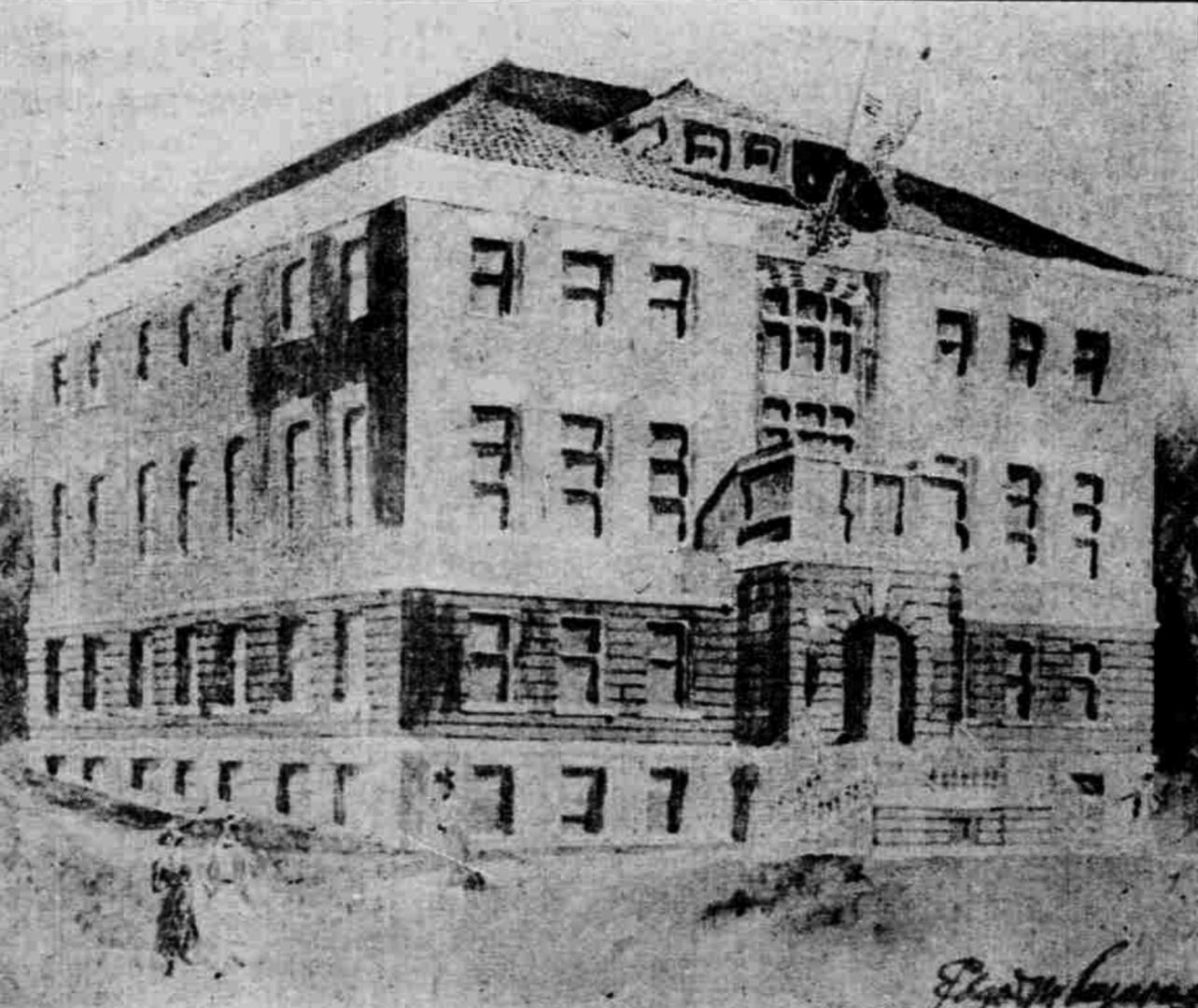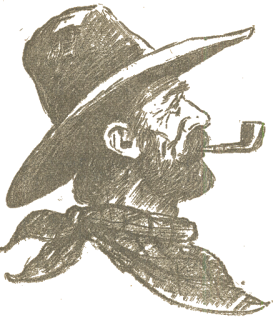
George Bruce Marquis, not to be confused with the George Bruce of aviation pulp fame, wrote more than a hundred stories in a forty year career in the pulps, starting in 1912 in The Cavalier, and ending in Short Stories in 1951. Most of his stories were westerns, many featuring a series character called Bat Jennison – a wandering cowboy knight errant. I got interested in him after reading a couple of stories in West, and decided to look him up. This article is the result, mostly based on the accounts in the Whitman College Archives Newsletter.
George Bruce Marquis was born on 6 July 1879 to Benjamin and Tabitha Marquis, nee Coupland in Valley, Reno, Kansas – about 160 miles from the geographic center of the contiguous United States of America. Benjamin Marquis was born in Missouri, but had to leave the state at the time of the Civil War as he was anti-slavery. Benjamin later served in the 12th Kansas Volunteers.
“The bushwhackers chased him out of Missouri (along with hundreds of pro-Union and anti-slavery men)… he was home on furlough at Lawrence the day after Quantrell and his raiders killed 142 people there. He never forgot that —the captured guide of Quantrell whom an angry gathering was going to hang and who ‘was the coolest man of the bunch’; nor the old man, ordinarily a religious and quiet-spoken man, who stood looking at the body of one of the Confederate raiders lying in the dust and the – sunshine, face upturned, lips pulled back in a final grimace, and the old man saying, ‘Grin, you ____, grin…’ “
In 1881, the family decided to move to Oregon and settle there. George, his elder sister, Mary and a three week old younger brother, Alfred and their parents took off in a covered wagon that started from Kansas on May 18 and reached their destination ten miles northeast of Pendleton, near Adams, Oregon on August 12. There was no town or railroad. His father was a county assessor and storekeeper, “and while he had a farm, I wouldn’t call him a farmer.”
With the coming of the railroad about 1885, Adams became a town (a very small one, with a population of less than three hundred people) and more and more people began to come into eastern Oregon. Among them were many “great, long, lean hungry men” (as George Marquis calls them).
Men like “Spratling and Junkins, who had been prospectors and were farmers when I knew them. There was the mysterious ‘Doc’ Levitt, a tall, slender fellow who was often in his cups but never submerged. He just ‘worked around, ’ as they say; obviously a man of parts, erudite and a farmer physician. When I knew him he worked at a mill in the mountains above Weston. Nobody knew about his past life, or whether Levitt was his real name, but he once performed a remarkable emergency operation on a woman. Levitt is one of my favorite characters. ” (Doc Levitt would later become a character in Marquis’ stories of Bat Jennison.)
“Many readers have asked me to write out Levitt’s story, but somehow I’ve never been able to ‘see’ it. And then there was ‘Whispering’ Thompson, a freighter who drove sixteen matched blacks and who could be heard talking to his mules for a distance of two miles! An artist with his bullwhip, he weighed about 250 pounds— a giant of a man about whom an Indian once said: ‘Him heap dug-out!’”
Another character was Hank Vaughn. A quiet man who lived with violence, he was killed by a horse in Pendleton in 1894. In that year, George Marquis saw him while George and his father were traveling by train. Vaughn was making his way through the train, offering a whiskey bottle to all the men, calling out: “if you don’t take a drink, you’re either a Democrat or a (censored)…” His father was a strong Republican, but also a teetotaler. “I’m kind of sorry we got off before Vaughn got to us, ” he says. “I always wondered what my father would have done! ”
There’s no doubt about the violence in Vaughn’s life, Marquis admits, such as the time Hank killed three train robbers in Montana and got a life-time pass on the railroad. But he was no bully, George avows, and Vaughn’s trouble was mainly with those looking for trouble.
Marquis attended country school and graduated from the old Eastern Oregon State Normal School at Weston in 1898. It was the nearest school, being about 10 miles distant from his home.

George Marquis pitched baseball for E. O. S. N. S., and after graduation planned to attend University of Oregon. However, in the fall of 1900 he came to Walla Walla (less than 20 miles from his home) to visit a friend of his, Marion Kees (son of Nancy Osborne of the Whitman massacre) who was steward at Billings Hall, then the men’s dormitory of Whitman College.
“They registered me before I hardly had time to realize what was happening. They brought me into this very room (his present office). Miss Louise Loomis was the registrar and also taught Greek. That was October 19, 1900. I had some money that first year. The next fall I landed here with ten dollars. Most of us were pretty poor. Like many an early-day student, I bucked wood for the stoves in Prentiss hall and repaired chairs at fifteen cents an hour.”
He was a star on the college’s baseball team. A left-handed pitcher, Marquis lost only one game in three years of play, to Washington State in 1902. During his first year, he chalked up 176 strikeouts, 42 of them in one week against Seattle, the Walla Walla town team and Washington State. He had no-hitter victories over University of California (6-3, they scoring on errors) in 1902, Oregon in 1907 when only 28 men came to bat and one man reached base, and the Town team in 1907 during a seven-inning game.
His college career was interrupted. In 1903, he married Agnes Houck of Joseph, Oregon, a classmate at Whitman College. From 1903 – 1906, he was assistant principal and then principal of Athena high school, near his home in Oregon.
Returning to Whitman College in 1906, he became assistant treasurer, carried a full schedule of classes, played baseball and at night studied law from 1906 to 1912 when he was admitted to the Washington State bar. He practiced for about six years with A. H. Reynolds & Grant Bond and continued to work at the College, while simultaneously trying to write.
He sold his first story in 1911, though it was published in 1912. When he first took on the treasurer’s job, he intended to resume teaching and regarded the job as a means of getting more college work. He ended up doing the job for the next 43 years.
“My first commercial story was ‘The Vagrant Safe’, which I sold to Munsey in June of 1911. I got twenty dollars for that story—the biggest check I ever got. Mrs. Marquis was out of town, I remember, when the check came. I put it on the table and looked at it. Then I walked around the table, looking at it from all angles. I suppose the biggest thing it did was to open a new world. I hadn’t known before just what all was entailed; imagine getting money for a story!”
He wrote at night, considering 10 p. m. to 2 a. m. the ideal time to write and keeps the coffee pot boiling. His son, Welton, was a musician and part of a banjo trio at school. They would practice late at night in their parents’ houses, and when they were in Marquis’ home, he would sometimes come and visit them in the middle of his writing, tell them a story and get back to his writing.
He did his work in longhand. He thought out stories in some detail, made only a few notes (“One I’m on now started with a single sentence, but I don’t know just where that sentence will crop up”) and never outlined completely. He had the same trouble most writers have with minor characters-riding herd on them so they didn’t overshadow the protagonist. He never tried writing plays, radio scripts or movies. Most of his output was in short story form, about three-quarters of it, the rest being novella length.
“I can’t write a love story, and I suppose that, as much as anything, has prevented my trying more long work. I asked the editor of West about taking up writing as a full-time job in about 1930, when I was making good money and regularly. He advised against it. I took the advice and have never regretted it. For example, at one time during the depression I was ‘pushing the work’ too hard. Like almost everyone, I needed more money. But something seemed to have happened. I got rejections on stories which I have since re-written and sold. I have had some regrets about writing because it killed our social life, but regretted mostly for Agnes’ sake. You know, what with one thing and another, I didn’t take a vacation until 1927.”
In 1925, Marquis introduced the character of Bat Jennison in story in Short Stories. The last name, he thinks, was picked from his father’s army captain about whom the elder Marquis had many an anecdote. Bat is a combination of Hank Vaughn and an early-day town marshal at Athena, Jimmy Stamper. The latter was small, weighing about 130 pounds, as Marquis pictures Bat Jennison.

“Lots of people say that Jennison is you (meaning himself). They say, ‘He’s always doing things you wanted to do. ’ I don’t know about that. I know what Jennison would do; I don’t know what I would do under the same circumstances. I picture him as a man who practiced all the western vices and was a slave to none. He gambled, drank and was afraid of women. He’s been described as a knight errant born out of his time.”
More than half of his output was Bat Jennison stories – stories featuring him appeared in Short Stories, West, Wild West Weekly, Super Western and Western Trails. He retired as bursar of Whitman College in 1949. He continued writing after retirement and sold his last story in 1951, to Short Stories. Fittingly, Dunnage from Hell was a Bat Jennison story.
His health was poor in the last years of his life, and he passed away on Feb 21, 1955, after a brief stay in hospital. He was survived by his wife, Agnes, and his two sons – Marion A. Marquis of Seattle, Washington, George Welton Marquis, then dean of the school of music at women’s college of the University of North Carolina, Greensboro and a daughter, Mrs. Henry P. Westerkamp of Edmonds, Washington.
Nice to come across Mr Marquis’s biography. It’s a reasonably unusual name and my middle name. I’m told some twenty years ago or so by a lady from New England that the Marquis’s or at least the Scottish ones derived from refugees fleeing religious persecution in France.
I’ll make a point of looking up a few of his stories and finding out a little more about him.
Nice to have you here. Let us know when you read them. Try the Internet Archive for a few:
https://archive.org/search?query=%22george+bruce+marquis%22&sin=TXT